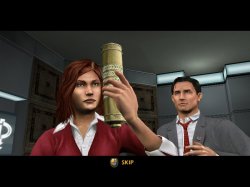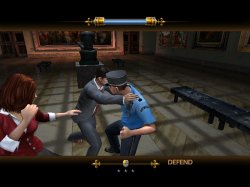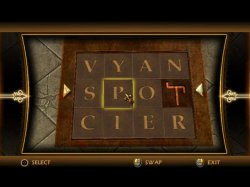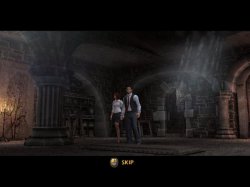|
The Da Vinci Code
 You've read the book! You've seen the movie! Now play the game! If you've done the first two then you'll know that the movie pretty much retains the spirit of the book. But what about the game? Ah, now here we have a problem. If ever a book or movie was ideally placed to be made into a puzzle-based adventure game then Dan Brown's bestseller is it. And most adventurers have encountered some of the themes of The Da Vinci Code before, most notably in Gabriel Knight 3: Blood of the Sacred, Blood of the Damned, which was also inspired by the book The Holy Blood and the Holy Grail. So here we have a ready market of adventure game players salivating for more Templar intrigue and Grail lore, more cryptic puzzles and an exciting cinematic story. And more than this, given the film tie-in and the undoubted popularity of the book, could The Da Vinci Code be the game that finally reaches out to that largely-untapped mass market of devoted readers and movie goers, and turn them on to the delights of interactive storytelling?
Er, no.
There are several reasons for this, some of which I have outlined in my article Another Missed Opportunity, but the main reason is summed up succinctly in the manual's proud boast, 'There is something for everyone here ...' which almost guarantees that there are elements that are sure to annoy some players.
Dan Brown's story begins as a murder mystery in which Robert Langdon is the prime suspect, before it quickly evolves into an epic 2000 year-old conspiracy that is uncovered by the expedient of an academic and a cryptographer literally solving a series of puzzles. Anagrams, conundrums and riddles abound. There should be no problem with making this into an adventure game. Unfortunately, the traditional adventure game market is seen as too small to justify the expense of making such a game, and appealing to the untapped non-gameplaying readers or movie fans is seen as too risky. The safest option is a no-brainer. Simply aim to include the existing acknowledged audience for computer and console games and stick in lots of combat. Hang on, I hear you say, "There isn't lots of combat in the book or the movie." True, but this is an action adventure game so you've got to have combat. Lots of it. You've read the book! You've seen the movie! Now play the game! If you've done the first two then you'll know that the movie pretty much retains the spirit of the book. But what about the game? Ah, now here we have a problem. If ever a book or movie was ideally placed to be made into a puzzle-based adventure game then Dan Brown's bestseller is it. And most adventurers have encountered some of the themes of The Da Vinci Code before, most notably in Gabriel Knight 3: Blood of the Sacred, Blood of the Damned, which was also inspired by the book The Holy Blood and the Holy Grail. So here we have a ready market of adventure game players salivating for more Templar intrigue and Grail lore, more cryptic puzzles and an exciting cinematic story. And more than this, given the film tie-in and the undoubted popularity of the book, could The Da Vinci Code be the game that finally reaches out to that largely-untapped mass market of devoted readers and movie goers, and turn them on to the delights of interactive storytelling?
Er, no.
There are several reasons for this, some of which I have outlined in my article Another Missed Opportunity, but the main reason is summed up succinctly in the manual's proud boast, 'There is something for everyone here ...' which almost guarantees that there are elements that are sure to annoy some players.
Dan Brown's story begins as a murder mystery in which Robert Langdon is the prime suspect, before it quickly evolves into an epic 2000 year-old conspiracy that is uncovered by the expedient of an academic and a cryptographer literally solving a series of puzzles. Anagrams, conundrums and riddles abound. There should be no problem with making this into an adventure game. Unfortunately, the traditional adventure game market is seen as too small to justify the expense of making such a game, and appealing to the untapped non-gameplaying readers or movie fans is seen as too risky. The safest option is a no-brainer. Simply aim to include the existing acknowledged audience for computer and console games and stick in lots of combat. Hang on, I hear you say, "There isn't lots of combat in the book or the movie." True, but this is an action adventure game so you've got to have combat. Lots of it.
 On this excursion you will fight your way out of the Louvre, a bank vault, Saint Sulplice, Sauniere's mansion, Teabing's house, an underground bunker, the Temple Church and Westminster Abbey. Only at Roslyn Chapel in Scotland will you find peace. Beneath this tacked-on combat layer there is a potentially intriguing game where the puzzles are solved and the story unfolds.
As an adventure game player who can handle a little action I was expecting some token combat but I was frequently frustrated by the sheer amount. Nor was this the sole cause of my angst, but more on that later. Fortunately you can choose to select one of three combat difficulty settings but even on easy mode The Da Vinci Code still had its frustrations. To be fair, you can use stealth to avoid some conflicts or to sneak up on your would-be assailants and strike the first blow. You can also generally find a clubbing-type weapon handy or an item to use as a distraction. But this doesn't always happen.
Combat involves performing a series of left, right or double mouse clicks when the game signals that you should do so with a series of graphics at the bottom of the screen. If you are too slow, or left click when you should have right clicked, then your attacking or defensive manoeuvre is likely to fail. Needless to say, failure to follow the commands means your opponent gets the upper hand and your health diminishes rapidly. Often there are several rounds to a fight, and sometimes you will have more than one opponent so if one hits you while you're grappling with the other your actions will fail. Once your health is gone you will be knocked out and have to repeat the whole process. Between fights you can heal yourself by applying bandages or using first aid kits that some thoughtful person has left lying around for you to find. On this excursion you will fight your way out of the Louvre, a bank vault, Saint Sulplice, Sauniere's mansion, Teabing's house, an underground bunker, the Temple Church and Westminster Abbey. Only at Roslyn Chapel in Scotland will you find peace. Beneath this tacked-on combat layer there is a potentially intriguing game where the puzzles are solved and the story unfolds.
As an adventure game player who can handle a little action I was expecting some token combat but I was frequently frustrated by the sheer amount. Nor was this the sole cause of my angst, but more on that later. Fortunately you can choose to select one of three combat difficulty settings but even on easy mode The Da Vinci Code still had its frustrations. To be fair, you can use stealth to avoid some conflicts or to sneak up on your would-be assailants and strike the first blow. You can also generally find a clubbing-type weapon handy or an item to use as a distraction. But this doesn't always happen.
Combat involves performing a series of left, right or double mouse clicks when the game signals that you should do so with a series of graphics at the bottom of the screen. If you are too slow, or left click when you should have right clicked, then your attacking or defensive manoeuvre is likely to fail. Needless to say, failure to follow the commands means your opponent gets the upper hand and your health diminishes rapidly. Often there are several rounds to a fight, and sometimes you will have more than one opponent so if one hits you while you're grappling with the other your actions will fail. Once your health is gone you will be knocked out and have to repeat the whole process. Between fights you can heal yourself by applying bandages or using first aid kits that some thoughtful person has left lying around for you to find.
 On a more positive note the puzzling is extended with new locations to explore that were not in the book or the movie. This I saw as more appropriate to the game than relentless combat. Any game (or movie), generally has a certain amount of license to deviate from the original source, thus Sauniere's mansion and the underground bunker at Biggin Hill Airfield in England provide the opportunity for more exploration and puzzle solving, as do the new areas in the more familiar landmarks such as Saint Sulplice and Westminster Abbey.
The puzzling and adventuring parts of The Da Vinci Code are much better handled. There are some inventory items to collect and use, secret codes to decrypt, and riddles to solve leading on to more clues and puzzles. The puzzles are fairly easy and only a couple can be described as abstract such as lighting a fire at each point of a pentagram so that they all stay lit. There are also some simple sliding tile puzzles and a hedge maze to explore. The inventory-based obstacles are also not difficult as you usually find the items you need close at hand so there is almost no backtracking.
Many of the puzzles also provide hints to help you solve them so that you need not be held up too long and can quickly get back to the action, if that is your preference. I must admit I was hoping for one or two really complex or extended puzzles. Solving a series of riddles in Westminster Abbey was as close as it got, although the relative simplicity of the puzzles does make the game more accessible to first time adventurers.
As you wander around a location the game will indicate when there is an object you can interact with. Once again you must watch beneath the screen for the prompt to do something. Pressing the E key at these times will bring up a close-up screen. In this screen you can use the mouse to interact, for example, open a drawer or press buttons. Sometimes you might need to use an inventory item and that requires pressing the Q key to open the inventory, the arrow keys to highlight or select an item and then press the E key twice to use it. Right clicking the mouse enables you to exit the close-up screen. It is a little cumbersome but you will get used to it. On a more positive note the puzzling is extended with new locations to explore that were not in the book or the movie. This I saw as more appropriate to the game than relentless combat. Any game (or movie), generally has a certain amount of license to deviate from the original source, thus Sauniere's mansion and the underground bunker at Biggin Hill Airfield in England provide the opportunity for more exploration and puzzle solving, as do the new areas in the more familiar landmarks such as Saint Sulplice and Westminster Abbey.
The puzzling and adventuring parts of The Da Vinci Code are much better handled. There are some inventory items to collect and use, secret codes to decrypt, and riddles to solve leading on to more clues and puzzles. The puzzles are fairly easy and only a couple can be described as abstract such as lighting a fire at each point of a pentagram so that they all stay lit. There are also some simple sliding tile puzzles and a hedge maze to explore. The inventory-based obstacles are also not difficult as you usually find the items you need close at hand so there is almost no backtracking.
Many of the puzzles also provide hints to help you solve them so that you need not be held up too long and can quickly get back to the action, if that is your preference. I must admit I was hoping for one or two really complex or extended puzzles. Solving a series of riddles in Westminster Abbey was as close as it got, although the relative simplicity of the puzzles does make the game more accessible to first time adventurers.
As you wander around a location the game will indicate when there is an object you can interact with. Once again you must watch beneath the screen for the prompt to do something. Pressing the E key at these times will bring up a close-up screen. In this screen you can use the mouse to interact, for example, open a drawer or press buttons. Sometimes you might need to use an inventory item and that requires pressing the Q key to open the inventory, the arrow keys to highlight or select an item and then press the E key twice to use it. Right clicking the mouse enables you to exit the close-up screen. It is a little cumbersome but you will get used to it.
 The Da Vinci Code game is a third person perspective action adventure. Sometimes you will play as Robert and sometimes as Sophie. Navigation is by using the W, A, S, D keys and I wasn't able to find any way to remap them. Most of the time you can 'steer' your character by using the mouse but there are one or two locations where only the W, A, S, D keys will work.
You will also need to carry out some actions such as breaking down a door or pushing an obstacle by repeatedly tapping the E key (to build up your strength) then quickly pressing another key when indicated and moving the mouse at the same time. Other actions such as pulling a lever require different key and mouse combinations. Once again you simply follow directions and, like the combat, these actions are repetitive and are really just nuisance value. The Da Vinci Code game is a third person perspective action adventure. Sometimes you will play as Robert and sometimes as Sophie. Navigation is by using the W, A, S, D keys and I wasn't able to find any way to remap them. Most of the time you can 'steer' your character by using the mouse but there are one or two locations where only the W, A, S, D keys will work.
You will also need to carry out some actions such as breaking down a door or pushing an obstacle by repeatedly tapping the E key (to build up your strength) then quickly pressing another key when indicated and moving the mouse at the same time. Other actions such as pulling a lever require different key and mouse combinations. Once again you simply follow directions and, like the combat, these actions are repetitive and are really just nuisance value.
This is where some of the frustration I alluded to above comes in. You can only save your progress when the game indicates a checkpoint. So you may have explored part of a location, solved two or three puzzles, and been successful at a couple of fights but fail on the third fight and it's back to start all over again from your last save or from the beginning of the level or 'mission'. This becomes tedious very quickly and I, for one, do not derive enjoyment from repeating actions over and over until I get it right. I can't believe that action game players enjoy this sort of gameplay either.
They say that playing action games is cathartic and does not lead to increased levels of violence. I can now attest that this is not true. After numerous combat failures I wanted to kill someone or inflict serious self harm.
So if combat is a turn off for you, be warned, it is a major part of the gameplay and, for me at least, it discouraged leisurely exploration. Here I have a confession to make. I was over half way through when I decided to take advantage of the option to input a code in one of the menu screens. What a good idea! I didn't feel too bad because it seemed to be expected. So a quick search of the Internet located two useful cheat codes to give infinite health and a first strike knockout hit. From that moment on I resorted to seeking out potential trouble makers and putting them out of action as quickly as possible so that I could explore at leisure. I started to enjoy the game much more from that point, though there were still a couple of action/strategy sequences that no cheat could fix.
Exploration is important in The Da Vinci Code as certain artefacts (or secrets) are hidden in the gameworld. These may be spheres, or coins or small models of some of Leonardo Da Vinci's inventions. These items, once collected, do not go into the inventory but into the visual database which you can access by pressing the Tab key. If you collect all the secrets in all locations you are rewarded with a couple of bonus levels at the end of the game with more puzzling. At any time during the game you can access your visual database and learn more about Art, History, People, Places, Secrets, your current objective, and any clues you may have uncovered. There is some interesting reading and this added to the game. You don't need to collect all the secrets to finish so I was a bit disappointed with this console-style trivial pursuit and thought that the items could have been much more integrated into the gameplay.
I liked the cinematic look of the game and the graphics and character modelling are pretty good. I had some fun just running around and scaring the pigeons in London. The characters are not voiced by the actors in the film but they are reasonable just the same. Playing as Langdon you can talk to Sophie and vice versa though usually your companion will only tell you variations on the theme of, "You need to look around some more." Conversations and expositions are played out in cut scenes which you can skip if you have seen them before. You can also enable subtitles.
The music is excellent, suitably dark and soaring where appropriate and subtle yet menacing at other times. The sound effects and background sounds such as traffic, wind, and rain are pretty good too and I liked some of the little things like the sound of Sophie's footsteps changing as she moved from a wooden floor onto the carpet.
The Da Vinci Code comes on one DVD and installs completely to the hard drive, though you do need to keep the disk in the drive for the game to run.
All things considered, it could have been an excellent adventure game if the focus had remained on puzzle solving to uncover the secrets contained within the conspiracy. The exploration is enjoyable and, even if they are fairly easy, the puzzles and riddles work well.
Creating a game for everyone is sure to have its pitfalls and The Da Vinci Code has fallen foul of them. I suspect that action fans won't be overly impressed by the prescribed follow-the-leader fighting system, and it's sure to frustrate adventure fans ... remember the cheats and it's quite playable. It is fascinating visiting so many intriguing locations, and there's some puzzling fun to be had. Those new to computer games who are tempted to try it thinking it will place them at the heart of the story they enjoyed in other media will likely be quite surprised by the amount of combat. It remains to be seen if they will embrace this game.
Whatever your feelings about the subject matter of the story it does provide an intriguing mystery to solve but the developers really needed to concentrate on those elements that made the book a bestseller.
Just a final observation. In both the book and the movie Opus Dei is named but in the game they have morphed into Manus Dei (Hand of God). I wonder why the name change was considered necessary? Is this yet another conspiracy?
Copyright © Gordon Aplin 2006.
All rights reserved.
System Requirements:
Minimum
Windows 2000/XP, 1.8 Ghz P 4 / 1.8 Ghz AMD Athalon or faster, 512 MB RAM, 64 MB graphics card with hardware transform and lighting, 100% compatible with DirectX 9c (does not support nVidia GeForce 3 and 4 series MX cards), 6X DVD drive or faster, 3GB hard-drive free space, 100% DirectX 9c compatible sound card, keyboard and mouse.
|

